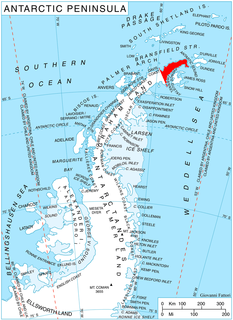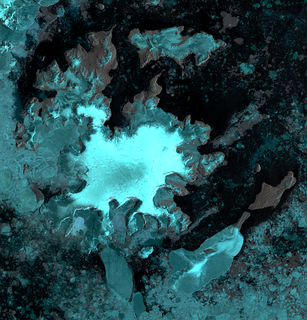
The Seal Islands are a group of small islands and rocky islets lying about 7 km north and north-west of Elephant Island, in the South Shetland Islands of Antarctica. They extend east–west for about 5 km, and are separated from Elephant Island by Sealers Passage. The group takes its name from the largest island, which Captain William Smith named Seal Island in 1820 because of the number of seals killed there.

Grenadines is an administrative parish of Saint Vincent and the Grenadines. Its capital is Port Elizabeth.
Leonardo Glacier is a glacier flowing into Wilhelmina Bay between Sadler Point and Café Point, on the west coast of Graham Land, Antarctica. It was charted by the Belgian Antarctic Expedition under Gerlache, 1897–99, and was named by the UK Antarctic Place-Names Committee in 1960 for Leonardo da Vinci, artist, musician, architect and the first aeronautical scientist.
Meade Nunatak is a nunatak 3 nautical miles (6 km) north of Blanchard Hill, rising to 990 metres (3,250 ft) in the Pioneers Escarpment, Shackleton Range, Antarctica. It was photographed from the air by the U.S. Navy, 1967, and was surveyed by the British Antarctic Survey, 1968–71. In association with the names of pioneers of polar life and travel grouped in this area, it was named by the UK Antarctic Place-Names Committee in 1971 after English mountaineer Charles Francis Meade, the designer of the Meade tent.

Aitkenhead Glacier is a 10-mile (16 km) long glacier flowing east-southeast from the Detroit Plateau, Graham Land, into Prince Gustav Channel. It was mapped from surveys by the Falkland Islands Dependencies Survey (FIDS) (1960–61), and named by the United Kingdom Antarctic Place-Names Committee for Neil Aitkenhead, a FIDS geologist at Hope Bay (1959–60).
Böhnecke Glacier is a steep glacier 3 nautical miles (6 km) wide, which flows southeast to the northwest side of Violante Inlet, on the east coast of Palmer Land. It was discovered and photographed from the air in December 1940 by members of the United States Antarctic Service. During 1947 the glacier was photographed from the air by members of the Ronne Antarctic Research Expedition under Finn Ronne, who in conjunction with the Falkland Islands Dependencies Survey (FIDS) charted it from the ground. It was named by FIDS for Gunther Böhnecke, a German oceanographer and a member of the German expedition in the Meteor, 1925–27.
Bolinder Bluff is a prominent bluff crowned by three buttresses of dark grey and light brown rock, overlooking Venus Bay 3 nautical miles (6 km) southeast of False Round Point on the north coast of King George Island, in the South Shetland Islands. The feature was known to sealers using the anchorage at nearby Esther Harbor in the 1820s. It was charted and named by Discovery Investigations personnel on the Discovery II in 1937 when the breakdown of the Bolinder boat engine caused 6 men to be marooned for 9 days on the beach at the foot of the bluff.
Bolton Glacier is a glacier flowing into the head of Briand Fjord, Flandres Bay, on the west coast of Graham Land. It was mapped in 1959 by the Falkland Islands Dependencies Survey from photos taken by Hunting Aerosurveys Ltd in 1956–57, and named by the UK Antarctic Place-Names Committee for William B. Bolton (1848–89), English photographer who, with B.J. Sayce, invented the collodion emulsion process of dry-plate photography in 1864.
Cayley Glacier is a glacier flowing northwest into the south side of Brialmont Cove, on the west coast of Graham Land. It was photographed by the Falkland Islands and Dependencies Aerial Survey Expedition in 1956–57 and mapped from these photos by the Falkland Islands Dependencies Survey. It was named by the UK Antarctic Place-Names Committee in 1960 for Sir George Cayley, English engineer, the "father of aeronautica," who first defined the main principles of mechanical flight, 1796–1857, and also designed the first caterpillar tractor in 1826.
The Darbel Islands are a group of islands and rocks extending southwest from Cape Bellue for 5 nautical miles (9 km) across the entrance to Darbel Bay, off the west coast of Graham Land. They were charted in 1930 by Discovery Investigations personnel on the Discovery II and named Marin Darbel Islands after the bay in which they were found. Both names have since been shortened by the UK Antarctic Place-Names Committee.
Grinder Rock is the southernmost of a group of rocks extending from the southeast end of Intercurrence Island, in the Palmer Archipelago, Antarctica. It was shown on Argentine and Chilean government charts of 1957. The name, given by the UK Antarctic Place-Names Committee in 1960, is descriptive of this toothlike feature.

Eldred Glacier is a glacier 2.5 nautical miles (5 km) long, flowing to the north coast of King George Island immediately east of Potts Peak, in the South Shetland Islands. It was named by the UK Antarctic Place-Names Committee in 1960 for Andrew J. Eldred, Master of the sealing vessel Thomas Hunt from Stonington, Connecticut, who visited the South Shetland Islands in 1873–74, 1875–76, 1878–79 and 1879–80. During the latter season he took part in the unsuccessful search for the Charles Shearer.
Moby Dick Icefall is an icefall at the head of Destruction Bay, in the east of King George Island, in the South Shetland Islands. It was named by the Polish Antarctic Expedition of 1981 after the famous white whale of Herman Melville's novel Moby-Dick.
The Molnar Rocks are insular rocks lying 4 nautical miles (7 km) west of the middle of Lavoisier Island, in the Biscoe Islands of Antarctica. The rocks were mapped from air photos taken by the Falkland Islands and Dependencies Aerial Survey Expedition in 1956–57, and were named by the UK Antarctic Place-Names Committee for George W. Molnar, an American physiologist who has specialized in the reactions of the body to cold environments.
Green Glacier is a glacier on the east side of Graham Land, Antarctica, 15 nautical miles (28 km) long and 4 nautical miles (7 km) wide, flowing from the plateau northeast between Dugerjav Peak and Rugate Ridge, and then east into Vaughan Inlet next north of Pirne Peak and south of the terminus of Hektoria Glacier.

Howarth Glacier is a small glacier flowing south-southeast to Admiralty Sound along the west side of The Watchtower, in southeastern James Ross Island, Antarctica. It was named by the UK Antarctic Place-Names Committee in 1995 after Michael Kingsley Howarth, Deputy Keeper of Paleontology at the British Museum, 1980–92, and author of the Falkland Islands Dependencies Survey Scientific Report Number 21, Alexander Island.
Macleod Point is a point forming the southeastern tip of Liège Island, in the Palmer Archipelago, Antarctica. It was shown on an Argentine government chart in 1957, but not named. The point was photographed from the air by Hunting Aerosurveys Ltd in 1956-57, and mapped from these photos by the Falkland Islands Dependencies Survey in 1959. It was named by the UK Antarctic Place-Names Committee for John J.R. Macleod, a Scottish physiologist who was one of the discoverers of insulin in 1922.

Hole Rock is the largest of several rocks lying close north of North Foreland, the northeastly cape of King George Island, in the South Shetland Islands. It was charted in 1937 by Discovery Investigations personnel on the Discovery II and so named because a conspicuous hole extends through it.
Robinson Peak is a sharp peak on the ridge east of Rennell Glacier, standing 7 nautical miles (13 km) south of Mount Virginia in the Heritage Range. It was mapped by the United States Geological Survey (USGS) from surveys and U.S. Navy air photos, 1961–66, and was named by the Advisory Committee on Antarctic Names (US-ACAN) for Willard E. Robinson, a construction mechanic at Byrd Station in 1965. Robinson Peak was first successfully climbed on January 2-3, 2013 by Pachi Ibarra, Ralf Laier and Todd Passey.



![]()






